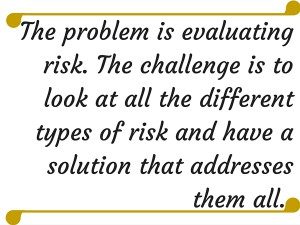Investment guidelines might harm investors
December 3, 2015

There are rules and regulations designed to keep investors safe. Sometimes those rules might backfire.
Recently I attended a conference designed to provide insight into guiding the type of advice given to clients. I think having strict rules in the investment industry is a good thing.
Regulators that are responsible for policing our industry are there to protect the general public. Rules have to be clear and enforced to set a minimum standard for all industry participants to follow.
The problem arises because financial planning and investment advice is a practical solution for developing the best strategy for a specific client. Rules implemented to protect everybody in some cases might not be appropriate for all investors.
At the conference an example was given for a retired couple who were dependent on their investment portfolio to have income in order to make ends meet. For the purposes of this column we will assume the couple are both 70 years old.
The question is, should that couple have equity investments, which are stocks, versus safer fixed income investments like bonds or Guaranteed Investment Certificates?
Assume the couple had 60 percent of their investment portfolio invested in equities and another stock market meltdown came along similar to what happened in 2008. A large part of the value of their equity investments would be lost.
Can a retired couple afford to lose a significant amount of their investment assets as a result of the stock market decline? Remember, stock market declines are normal.
In the context of the risk of stock market decline you can make a strong case that the retired couple had too much invested in equities. In the eyes of many within the investment industry, there is the risk that 60 per cent in equities might be challenged and put the advisor at risk.
Because of the potential risk to an investment advisor they might recommend a more conservative portfolio. 
The problem is evaluating risk. The challenge is to look at all the different types of risk and have a solution that addresses them all.
One risk is stock market decline. However a more significant risk for many retired investors is outliving their capital. It is not uncommon for people to live into their 90s so our 70-year-old couple could have 25 years to live.
In order for the investors to maintain their purchasing power after inflation it may be advisable to have a significant amount of their portfolio invested for the long term and therefore invested in equities.
Some might argue retired investors are not looking long term and for those who mistakenly believe that, we recommend they look at actuarial tables to confirm how long people live today.
As mentioned above, longevity is the greatest financial risk many Canadians face. Regulation or “guidelines” that encourages retired investors to have safer investments is, in my opinion, a mistake.
There is no magic formula that is suitable for every investor.
We recommend that investors identify all risks in conjunction with their investment objectives. The correct investment approach should be the one that had the greatest chance to achieve their investment objective with the least risk.
Rules and guidelines are useful to guide those providing investment advice. But the ultimate guideline should be to recommend what is best for each and every investor.
